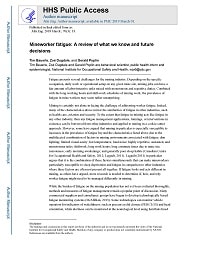Mining Publication: Mineworker Fatigue: A Review of What We Know and Future Decisions
Original creation date: March 2018
Authors: T Bauerle, Z Dugdale, G Poplin
Fatigue presents several challenges for the mining industry. Depending on the specific occupation, daily work or operational setup on any given mine site, mining jobs can have a fair amount of labor-intensive tasks mixed with monotonous and repetitive duties. Combined with the long working hours and shift-work schedules of mining work, the prevalence of fatigue in mine workers may seem rather unsurprising.
Mining is certainly not alone in facing the challenge of addressing worker fatigue. Indeed, many of the characteristics above mirror the similarities of fatigue in other industries, such as health care, aviation and security. To the extent that fatigue in mining acts like fatigue in any other industry, then any fatigue management applications, trainings, or interventions in existence can be borrowed from other industries and applied to mining in a cookie-cutter approach. However, some have argued that mining in particular is especially susceptible to increases in the prevalence of fatigue beyond the characteristics listed above due to the multifaceted combination of factors in mining environments associated with fatigue: dim lighting; limited visual acuity; hot temperatures; loud noise; highly repetitive, sustained, and monotonous tasks; shiftwork; long work hours; long commute times due to mine site remoteness; early morning awakenings; and generally poor sleep habits.1,2 Legault (2011)2 in particular argues that it is the combination of these factors simultaneously that can make mineworkers particularly susceptible to sleep deprivation and fatigue in comparison to other industries where these factors are often not present all together. If fatigue looks and acts different in mining, as others have argued, more research is needed to determine if, how, and why worker fatigue might need to be managed differently in mining.
While the burden of fatigue on the mining population has not yet been evaluated thoroughly, methods and measures of fatigue management remain a popular point of discussion. Many commercial suppliers and consultancy groups have begun to develop technologically based fatigue monitoring systems (McMillian, 2013). Some technologies can monitor vehicle operators for indicators of wakefulness, such as percent eyelid closure (PERCLOS) and head orientation, while alertness can be monitored at the neurological level using hard hats lined with electroencephalogram (EEG) activity tracking. While such systems could likely offer some utility in addressing fatigue, one criticism of using a stand-alone technology-centric approach is that the technology is usually meant to detect and mitigate worker fatigue that has already occurred and, therefore, does not necessarily prevent or mitigate fatigue from actually happening. Critics argue for a more comprehensive or systems approach that is work-centric and that aims to identify the root cause and outcomes of workplace fatigue. While the U.S. National Institute for Occupational Safety and Health (NIOSH) has previously developed fatigue- and shiftwork-related training materials targeting specific occupations,3 no work to date has focused specifically on addressing fatigue in the mining industry by using a comprehensive data-driven approach.
This article aims to concisely review what is and is not known about worker fatigue in mining. To accomplish this, three main research questions are used to frame this review:
- What is fatigue, and why does it happen?
- Why are fatigued workers more likely to be injured?
- What are the most effective ways to reduce worker fatigue?
1. Canadian Centre for Occupational Health and Safety, 2012. Fatigue fact sheet. Retrieved from: https://www.ccohs.ca/oshanswers/psychosocial/fatigue.html.
2. Legault G. Sleep and heat related changes in the cognitive performance of underground miners: A possible health and safety concern. Minerals. 2011;1:49–72.
3. Centers for Disease Control and Prevention. Work schedules: Shift work and long hours – educational resources for managers and workers. 2017 Retrieved from: https://www.cdc.gov/niosh/topics/workschedules/education.html.

- Characterization of the 1986 Metal and Nonmetal Mining Workforce
- Findings from a Systematic Review of Fatigue Interventions: What's (Not) Being Tested in Mining and Other Industrial Environments
- Mining Applications of Novel Interventions for Fatigue - Evaluating Safety Toolkits (MANIFEST)
- Pillar and Roof Span Design in Stone Mines
- Possible Impact of New Safety Technology Developments on the Future of the United States Mining Industry
- Reducing Low Back Pain and Disability in Mining
- Report on Early Strength Performance of Modern Day Weak Rock Mass Shotcrete Mixes
- Selected Health Issues in Mining
- Technique to Assess Hazards in Underground Stone Mines: the Roof Fall Risk Index (RFRI)
- Underground Mine Communications